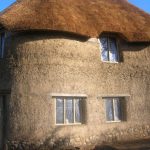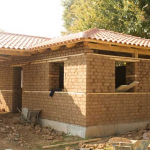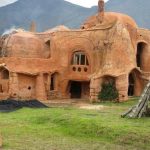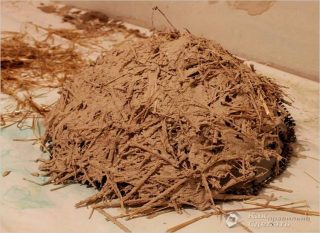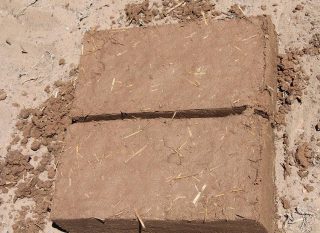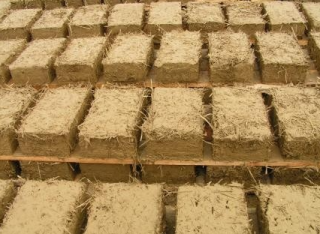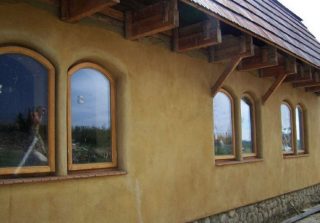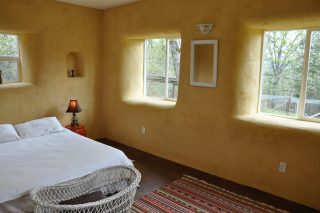Saman is the cheapest building material in existence. To build a house out of adobe, it is enough to dig a hole under the foundation, remove the clay from it, mix it with straw, hemp and flax waste and water. And then build walls from this "grazing" material.
Features of building a house from adobe
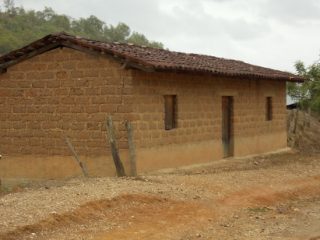
Technology clay house constructions known for over 5 thousand years... Huts, huts and one-story adobe cottages were built throughout Europe and Asia. In the 18th century, for example, 80% of houses in Great Britain were built from this material, as stone and wood were not enough for construction. In the east, adobe was used for the construction of mosques, mausoleums, temples. A similar technology was used even in the construction of fortress walls and towers.
Traditional method adobe construction assumed some kind of wall filling... For this, 2 wooden shields were made, set at the desired mark. The space between them was filled with a mixture of clay and straw. After hardening, the shields were removed, and windows and doors were cut through the wall. Later, they began to make bricks from adobe.... This somewhat diversified the architecture of adobe buildings.
Today adobe houses are being erected as an experiment... Modern technologies and additives give adobe more strength, especially bending. Now buildings of complex curvilinear shape are being erected from the same material, they are literally sculpted.
Advantages and disadvantages of the material
Adobe used in the absence of a more suitable material - wood, stone, brick. The advantages that he has now are largely due not to clay, but to additional building materials and technologies.

Adobe making and characteristics
For the construction of buildings, not the actual mixture of clay and straw is used, but adobe brick. It looks a little more aesthetically pleasing than cakes and rollers. The technology is simple: wooden molds are moistened with water, then a thick mixture of clay, straw and other fillers is poured inside.
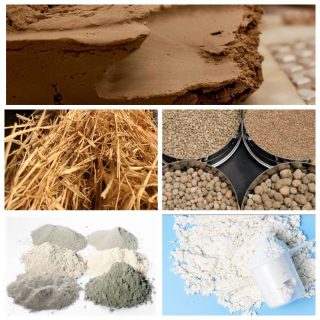
Brick characteristics depend on the material used.
- Clay - basic material. Take the usual red clay of medium fat content.
- To increase the resistance to bending load, substances with cellulose fibers... Most often it is straw, but wood shavings, chaff, fire and even manure are also used.
- To prevent shrinkage, adobe is added sand, gravel, expanded clay, crushed stone... The addition of gravel also increases the mechanical strength, but at the same time makes the brick heavier.
- Accelerate drying and hardening cement and lime... Lime is used more often because rodents don't like it.
- The stackability is increased casein, bone glue, liquid glass, as well as slurry, molasses, starch.
Ready mix for adobe should be dense enough, but retain viscosity... When dried in molds, the mixture should not crack or crumble. The optimal composition is determined empirically by mixing several samples with different contents of clay and fillers.
The fat content of the clay is selected in accordance with the quantity and quality of fillers. This also requires testing.
By density and method of use distinguish between light and heavy adobe.
- Easy - a mixture with a high filler content and a clay content of 10%. In fact, it is straw, lightly smeared with clay. The material is used to fill the formwork. Light adobe is more often used in the south, where thick walls are not needed.
- Heavy - the brick itself. In heavy adobe, the proportion is higher - up to 50-60%, and more, the proportion of sand is greater - up to 30%. The content of straw, shavings or other fillers does not exceed 10%. Such material solidifies in forms, turning into brick.
The main difficulty is not the manufacture of adobe brick, but its storage. For a home, it must be produced in a fairly large volume, and it is allowed to save only in a completely dry place, since adobe absorbs moisture very well.
The nuances of working with adobe
When manufacturing and working with the material, the following should be considered recommendation.
- Clay is needed for stone medium fat... If it is oily, sand is added, and the latter increases the weight of the brick. It is better to prepare the material in the fall.
- The freshest straw is needed... It is allowed to use hay.
- Proportions batch cannot be accurate. The builder needs to independently determine the optimal composition.
- Prepare raw materials and leave the molds themselves on earth it is impossible... The material will pick up all debris from the surface.
- Dried adobe bricks, first in the sun - up to 2 days, then transferred under a canopy, placed on the edge and dried for another week.
The finished brick does not crumble or split when dropped from a height of 2 m.
How to build a house from adobe with your own hands
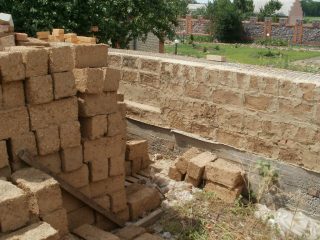
The technology for erecting adobe walls depends on the material used - light or heavy adobe. However, filling is not rational.
The surface of the foundation is leveled, waterproof with mastic or roofing material.
- A row of adobe bricks is laid out. The corners are set first. A lace is pulled between them and all the rest are put on it.
- For laying, take a liquid adobe dough. The thickness of the seam is about 1 cm. It is recommended to lay no more than 2 rows of adobe per day so that the solution has time to dry and set.
- Laying bricks offset... If size correction is required, use a hatchet.
- Thickness outward walls not less than 60 cm, internal - 30 cm.
- Along the perimeter of window and door openings, as well as at the junction of the walls, they are laid every 50 cm reed stalks or brushwood... It serves as an armature.
- The top row is under the roof, reinforce... It is best to make a reinforced concrete monolithic belt. The lightest roof is chosen.
The walls must be protected from rain. If it began before the completion of construction, the erected walls should be covered with foil. The adobe house shrinks strongly. In the project, the ceiling height is laid with a margin of 20-30 cm.
External and internal cladding
It is imperative to trim adobe walls. The material absorbs moisture and will not stand for a long time. The traditional option is plaster... Vapor-permeable compositions are chosen, like silicate, calcareous. It is better not to take cement, it does not adhere well to unbaked clay.
Allowed and other finishes: lining, boards, siding, brick. The latter must be laid with a gap between the adobe and the stone.
Used for interior decoration gypsum and clay plaster... Can be tiled. It is better not to use plastic panels, as they do not allow steam to pass through.

